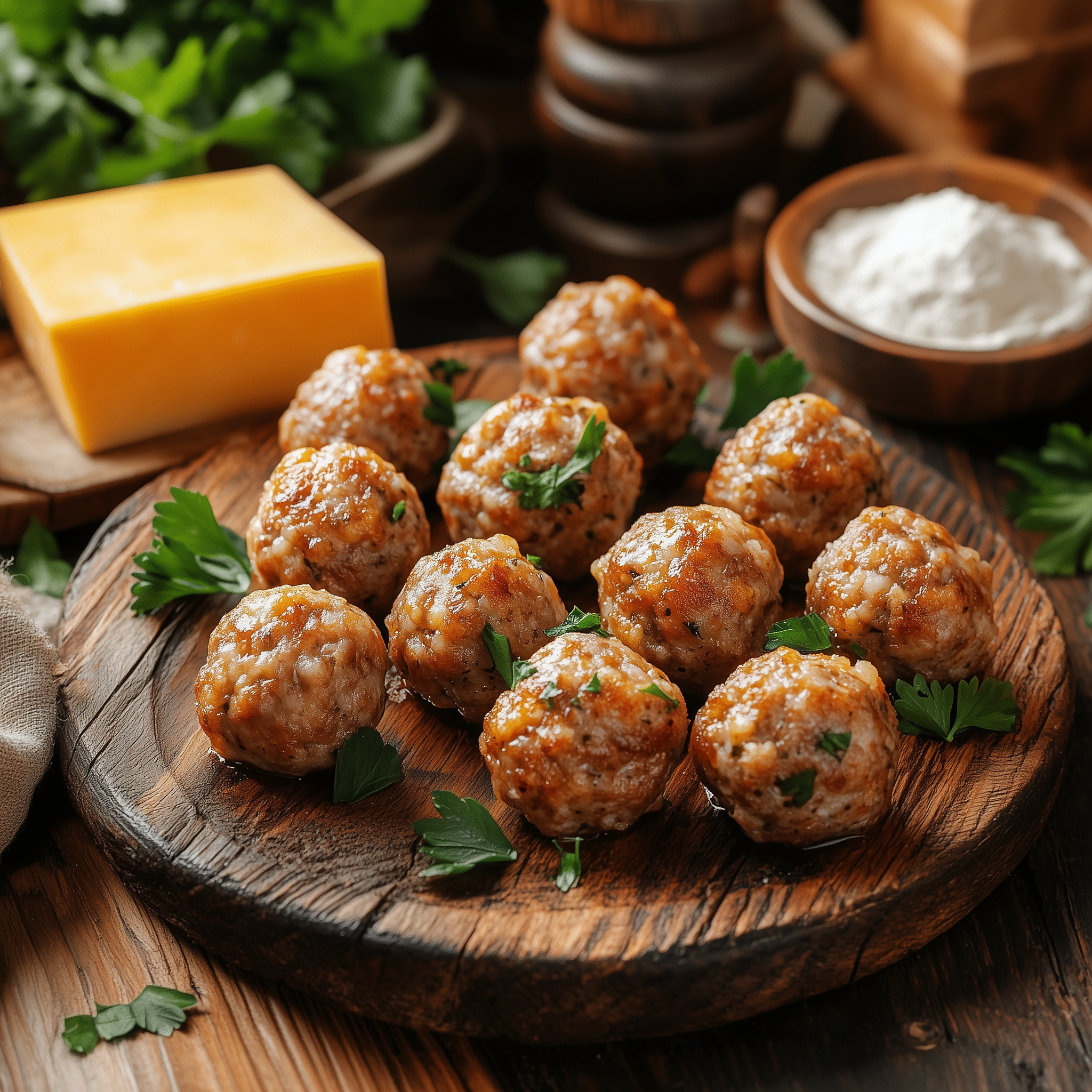Introduction to Sausage Balls and Bisquick
Sausage balls are a cherished snack or appetizer, celebrated for their savory flavors and versatility. Traditionally, these bite-sized treats rely on Bisquick, a convenient baking mix that combines flour, baking powder, shortening, and salt. This mix simplifies preparation while delivering consistent results. However, what happens when you run out of Bisquick or prefer to try something new? What else could you do to make sausage balls to replace Bisquick?
Bisquick’s widespread use stems from its ability to create a soft texture and reliable structure for sausage balls. Despite its popularity, there are countless alternatives and creative ideas for those looking to experiment. Whether you want a healthier option, a gluten-free version, or just want to try something different, the possibilities are endless. Let’s dive into exciting methods to prepare sausage balls that don’t require Bisquick, all while keeping their classic charm intact.
Creative Ways to Make Sausage Balls Without Bisquick
What else could you do to make sausage balls to replace Bisquick? The answer lies in getting creative with your pantry staples and exploring alternative ingredients. Below are some innovative options to achieve equally delicious sausage balls without compromising on flavor or texture.
Use Self-Rising Flour
- Self-rising flour combines flour, baking powder, and salt, making it a convenient replacement.
- You can prepare self-rising flour at home by mixing 1 cup of all-purpose flour, 1½ teaspoons of baking powder, and ¼ teaspoon of salt.
Try Pancake Mix
- Pancake mix offers a slightly sweeter base but works well when paired with savory sausage and cheese.
- To balance the sweetness, consider adding a pinch of garlic powder or black pepper.
Incorporate Gluten-Free Options
- Almond flour, coconut flour, or gluten-free all-purpose flour can replace Bisquick for those avoiding gluten.
- Keep in mind that almond flour may require additional binding agents like xanthan gum.
Experimenting with these alternatives offers countless ways to create sausage balls that are just as satisfying without the need for Bisquick.
Exploring Bisquick Substitutes
When you think about what else could you do to make sausage balls to replace Bisquick, understanding suitable substitutes is essential for maintaining the right texture and flavor. Whether you’re out of Bisquick or simply looking for a creative twist, there are several practical options to consider, each offering unique benefits to your recipe.
All-Purpose Flour and Baking Powder
A simple and effective alternative to Bisquick is a combination of all-purpose flour, baking powder, and fat. This mix can replicate Bisquick’s consistency, providing a reliable structure for your sausage balls.
- How to Prepare: Combine 1 cup of all-purpose flour with 1 tablespoon of baking powder and 2 tablespoons of softened butter or shortening.
- Why It Works: The baking powder acts as a leavening agent, while the fat adds the richness needed for a soft and cohesive texture.
This homemade mix ensures your sausage balls hold their shape without sacrificing the classic texture and flavor people love. It’s an easy solution for those who prefer homemade options or have limited ingredients on hand.
Store-Bought Baking Mixes
If you’re short on time, pre-packaged baking mixes are a convenient choice. Many brands offer mixes labeled as “all-purpose baking mix” that closely mimic Bisquick’s composition.
- How to Choose: Look for mixes with similar ingredients, like flour, leavening agents, and fat. Popular options include generic store brands and gluten-free variations.
- Versatility: These mixes work seamlessly in most sausage ball recipes, offering consistent results with minimal effort.
Store-bought options are perfect for busy cooks who want quick results without compromising on quality or flavor.
Bread Crumbs or Crushed Crackers
Bread crumbs and crushed crackers provide a unique alternative to Bisquick, particularly for those who enjoy experimenting with texture and taste.
- Why Use Bread Crumbs: They add a hearty texture and can be seasoned with spices like garlic powder or paprika to complement the sausage.
- Why Use Crushed Crackers: Crackers like Ritz or saltines introduce a buttery flavor and a slightly crumbly texture that pairs beautifully with sausage and cheese.
Both options are highly adaptable and allow you to customize the seasoning to suit your preferences. They also create an opportunity to use pantry staples you likely already have.
Each of these substitutes serves a unique purpose, making it easier to craft sausage balls tailored to your taste and ingredient availability. Whether you prefer the simplicity of homemade flour blends, the convenience of store-bought mixes, or the creativity of bread crumbs and crackers, you can confidently replace Bisquick without losing the essence of this beloved recipe.intaining the classic appeal of sausage balls.
Enhancing Sausage Balls with Unique Ingredients
One way to reimagine what else could you do to make sausage balls to replace Bisquick is by introducing unique and unexpected ingredients. These additions can elevate the flavor profile and add variety to your recipe.
Cheese Alternatives
Cheddar cheese is the go-to choice for sausage balls, but experimenting with other cheeses can create exciting variations:
- Gouda for a smoky touch.
- Pepper Jack for added spice.
- Parmesan for a sharp, nutty flavor.
Herbs and Spices
Incorporating fresh herbs or spices can bring new life to your sausage balls:
- Add parsley, thyme, or rosemary for an herby twist.
- Spice it up with paprika, chili powder, or cumin.
Vegetables for Moisture and Nutrition
Grated zucchini, carrots, or finely chopped spinach not only add nutrition but also help keep sausage balls moist. These ingredients blend seamlessly into the mixture and boost the overall texture.
By thoughtfully selecting these unique additions, you can transform traditional sausage balls into a culinary masterpiece tailored to your taste.
Creative Recipe Variations
If you’re wondering what else could you do to make sausage balls to replace Bisquick, experimenting with creative recipe variations is a fantastic approach. Here are some unique twists to suit different dietary needs and preferences:
Gluten-Free Sausage Balls
- Replace Bisquick with gluten-free baking mix or almond flour.
- Use xanthan gum as a binder to maintain texture and structure.
Keto-Friendly Sausage Balls
- Almond flour or coconut flour is an excellent low-carb substitute.
- Incorporate full-fat cheeses and high-quality sausage for the best results.
Vegan Sausage Balls
- Substitute plant-based sausage crumbles for traditional sausage.
- Use chickpea flour or ground flaxseed as the binding agent and pair with vegan cheese.
Cheese-Stuffed Sausage Balls
- Wrap sausage mixture around cubes of mozzarella or cheddar for a gooey surprise.
These variations highlight how flexible sausage ball recipes can be, ensuring there’s something for everyone while sticking to the theme of replacing Bisquick creatively.
Tips for Perfect Sausage Balls
Achieving perfection requires attention to detail, especially when you’re working out what else could you do to make sausage balls to replace Bisquick. These tips will help you get the best results every time:
Achieve the Right Consistency
- The mixture should be firm but slightly sticky to hold its shape.
- If it’s too dry, add a splash of milk or cream.
Use a Cookie Scoop
- A cookie scoop ensures evenly-sized sausage balls for consistent cooking.
Choose High-Quality Ingredients
- Select freshly grated cheese instead of pre-shredded for better flavor and texture.
- Opt for high-quality sausage to elevate the overall taste.
Baking vs. Frying
- Baking is healthier and cooks the sausage balls evenly.
- For a crispy exterior, fry the balls in a shallow pan of oil.
Storing and Reheating
- Store cooked sausage balls in an airtight container in the fridge for up to 3 days.
- Reheat in the oven to restore their crispiness.
By following these tips, you’ll create sausage balls that are consistently flavorful and perfectly textured.
FAQS
–What can I substitute for Bisquick in sausage balls?
If you don’t have Bisquick, don’t worry! You can use self-rising flour, which already includes leavening agents like baking powder and salt. Another option is to mix all-purpose flour with baking powder and a pinch of salt to create a homemade baking mix. For a unique twist, pancake mix also works, though you may need to add a bit of seasoning to balance the sweetness. Additionally, crushed crackers or bread crumbs can act as effective binders, especially when combined with other flavorful ingredients.
–What can I use instead of Bisquick?
Instead of Bisquick, there are several versatile substitutes that yield great results. Self-rising flour is a quick and easy choice, while a blend of all-purpose flour, baking powder, and salt is equally effective. If you’re in a pinch, crushed crackers or pre-made baking mixes can save the day. Gluten-free alternatives like almond flour or coconut flour are also excellent options if you’re catering to dietary needs. Each substitute can help maintain the deliciousness of your sausage balls without compromising texture or flavor.
–What are sausage balls made of?
Sausage balls are typically made of three main ingredients: ground sausage, shredded cheese, and a binder like Bisquick. The sausage provides a savory base, while the cheese adds richness and flavor. The binder holds everything together, creating the perfect bite-sized snack. Substitutes for Bisquick, such as self-rising flour or crushed crackers, can be used without altering the essence of the recipe. Some variations include spices, herbs, or vegetables to enhance the flavor and nutritional value.
–How to reheat sausage balls without Bisquick?
Reheating sausage balls without Bisquick is simple and ensures they stay delicious. Start by preheating your oven to 350°F (175°C). Place the sausage balls on a baking sheet, ensuring they don’t overlap, and heat for 8–10 minutes until warmed through. Alternatively, you can use a microwave for convenience, reheating them in 30-second intervals to prevent overcooking. For an extra crispy texture, consider reheating them in an air fryer at 375°F (190°C) for 3–5 minutes. This process keeps your sausage balls tasty and ready to serve.
Conclusion
In exploring what else could you do to make sausage balls to replace Bisquick, we’ve uncovered countless ways to create these beloved snacks without the need for the traditional mix. From self-rising flour to unique recipe variations like keto-friendly and vegan options, the possibilities are vast. Incorporating tips for achieving the ideal texture and trying out exciting ingredient combinations ensures your sausage balls remain flavorful and satisfying.
Whether you’re accommodating dietary restrictions or simply experimenting with new flavors, there’s no limit to how creative you can get. Armed with these ideas, you’re ready to craft sausage balls that are not only delicious but also customized to your tastes and needs.

